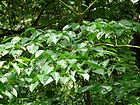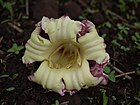Note: This is a project under development. The articles on this wiki are just being initiated and broadly incomplete. You can Help creating new pages.
Oroxylum indicum - Shyonaka
Shyonaka is a species of flowering plant belonging to the family Bignoniaceae, It is a tree which can reach a height of 12 metres.
Uses
Wounds, Cuts, Snakebites, Curing liver disorders, Skin eruptions, Blotches, Pimples, Diarrhea, Sore throats
Parts Used
Chemical Composition
Baicalein, oroxylin and pinostrobin along with one sterol, Stigmast-7-en-3-ol[1]
Common names
| Language | Common name |
|---|---|
| Kannada | Tattuna |
| Hindi | Bhut-vriksha |
| Malayalam | Palaqapayyani |
| Tamil | Cori-konnai |
| Telugu | Pampena |
| Marathi | NA |
| Gujarathi | NA |
| Punjabi | NA |
| Kashmiri | NA |
| Sanskrit | Aralu, Shyonaka |
| English | Broken Bones Tree, Indian Trumpet Flower |
Properties
Reference: Dravya - Substance, Rasa - Taste, Guna - Qualities, Veerya - Potency, Vipaka - Post-digesion effect, Karma - Pharmacological activity, Prabhava - Therepeutics.
Dravya
Rasa
Tikta (Bitter), Kashaya (Astringent), Madhura (Sweet0
Guna
Laghu (Light), Ruksha (Dry)
Veerya
Ushna (Hot)
Vipaka
Katu (Pungent)
Karma
Kapha, Vata
Prabhava
Habit
Identification
Leaf
| Kind | Shape | Feature |
|---|---|---|
| Compound | triangular | 2-3 pinnate, pinnae 5-9; imparipinnate, opposite; leaflets 3-5 in each pinnae, opposite, 7.5-15 x 4-9 cm, ovate, apex acuminate, base cordate, oblique or truncate, margin entire, glabrous, chartaceous; rachis 60-100 cm, stout, glabrous; lateral nerves, 4-6 pairs, pinnate, prominent, puberulent beneath; intercostae reticulate. |
Flower
| Type | Size | Color and composition | Stamen | More information |
|---|---|---|---|---|
| Bisexual | 10cm long | reddish-purple and pinkish-yellow | 5 | Flowers in terminal racemes, large, reddish-purple and pinkish-yellow within |
Fruit
| Type | Size | Mass | Appearance | Seeds | More information |
|---|---|---|---|---|---|
| flat | 30-90 cm long | compressed, tapering at both ends | seeds thin, papery, 5-6 cm long, winged all around except at base. | {{{6}}} |
Other features
List of Ayurvedic medicine in which the herb is used
Where to get the saplings
Mode of Propagation
How to plant/cultivate
Seed is the best propagation material and should be collected before split- ting of pods during February–March. Seed germination percentage is 80%–90% without any pretreatment. [4]
Commonly seen growing in areas
Photo Gallery
References
External Links
- Ayurvedic Herbs known to be helpful to treat Wounds
- Ayurvedic Herbs known to be helpful to treat Cuts
- Ayurvedic Herbs known to be helpful to treat Snakebites
- Ayurvedic Herbs known to be helpful to treat Curing liver disorders
- Ayurvedic Herbs known to be helpful to treat Skin eruptions
- Ayurvedic Herbs known to be helpful to treat Blotches
- Ayurvedic Herbs known to be helpful to treat Pimples
- Ayurvedic Herbs known to be helpful to treat Diarrhea
- Ayurvedic Herbs known to be helpful to treat Sore throats
- Herbs with Roots used in medicine
- Herbs with Leaves used in medicine
- Herbs with Fruits used in medicine
- Herbs with Seeds used in medicine
- Herbs with common name in Kannada
- Herbs with common name in Hindi
- Herbs with common name in Malayalam
- Herbs with common name in Tamil
- Herbs with common name in Telugu
- Herbs with common name in Sanskrit
- Herbs with common name in English
- Habit - Tree
- Index of Plants which can be propagated by Seeds
- Index of Plants which can be propagated by Cuttings
- Herbs that are commonly seen in the region of Tropical area
- Herbs that are commonly seen in the region of Borders of forests and fields
- Herbs
- Ayurvedic herbs that don't have seed photos
- Bignoniaceae





